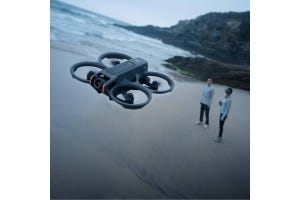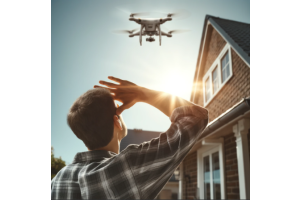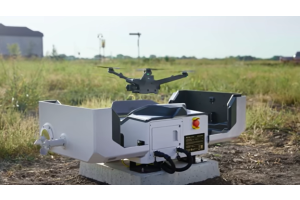Drones are being increasingly used across all industries, from entertainment and agriculture, to building inspections and public safety. But with these advancements come challenges, mainly managing operations and ensuring drone airworthiness. Enter DJI Flight Hub 2 and Airdata, two leading platforms addressing these concerns. But which is the best fit for your needs?
Whether you're about live drone feeds for real-time decision-making or are after predictive insights for your fleet, understanding the nuances of these platforms is crucial. Let's break down their features, user experience, and integration capabilities in a head-to-head showdown. Find out which one suits your operations in this review and guide.


Quick Overview of Key Features
DJI Flight Hub 2
- Universal Accessibility with Cloud Integration: Access data from any device, anytime.
- 2.5D Base Map Visual & One Tap Panorama Sync: Offers a detailed terrain view for pre-flight planning.
- Real-Time Cloud Mapping: Generates accurate orthomosaic maps with thermal capabilities.
- Live Annotations: Improves team coordination during missions.
- Data Security: Ensures information security with AWS and ISO 27001 compliance.
- KMLs and Geospatial Integration: Facilitates sharing of geographical annotations.
- Integration with New RC Plus: Simplifies connectivity to any cloud platform.
Who it's Best For:
Drone pilots and teams who prioritize live feed operations and real-time collaboration. This platform excels in dynamic environments like emergency responses and SAR missions, monitoring live events, and on-site industrial checks.
Airdata
- Simplified Drone Fleet Management: Makes managing multiple drones and pilots easier.
- Data Syncing & Automatic Flight Logs: Eliminates manual data entry.
- Real-time Flight Playback & Analysis: Offers an in-depth analysis of each flight's data.
- Instant Alerts and Maintenance Tracking: Timely notifications of potential issues.
- Pre-Flight and Post-Flight Checklists: Enhances flight safety.
- Service Recommendations & Records: Offers curated service templates.
- Remote ID Management: Meet FAA requirements
- Customizable Alerts and Notifications: Provides proactive alerts.
- Data Sharing: Ensures easy access to flight data for team collaboration.
Who it's Best For:
Enterprises and organizations with fleets of drones, focusing on in-depth analytics, maintenance, and compliance. It's the go-to for those needing robust fleet management, safety checklists, and performance optimization.
DJI Flight Hub 2 vs. Airdata - A Comparative Analysis
- Purpose and Utility
Flight Hub 2 primarily centers around live operations management. It is designed to make real-time data-sharing and collaboration between drone pilots and their teams seamless. This is especially beneficial in scenarios requiring rapid decision-making based on live drone feeds, like public safety, event coverage, or industrial inspections.
On the other hand, Airdata primarily serves as a comprehensive drone fleet management platform, focusing on predictive insights and ensuring drones remain airworthy. It offers deep analytics and helps optimize flight performance, ideal for businesses running multiple drone operations, training programs, or regular maintenance checks.
- User Experience
When it comes to user experience, both platforms prioritize simplicity. Flight Hub 2, with its cloud integration, offers a streamlined experience where data is instantaneously accessible, making it efficient for live operations. Features like the 2.5D Base Map offer a richer perspective and ease of use for pre-flight planning.
Airdata is all about the UAV's comprehensive data management. Its intuitive interface simplifies fleet management and offers features such as real-time flight playback, ensuring that users get a clear understanding of their operations. The platform's visual representation tools, like the 3D representation of the flight path in Google Earth, enhance user understanding.
- Integration Capabilities
Flight Hub 2 showcases impressive integration capabilities. The platform seamlessly syncs with DJI's recent enterprise drones from the Mavic 3 enterprise lineup to the flagship Matrice 350 RTK, as well as DJI Dock and the Matrice 30 it houses. It’s optimized for the Zenmuse H20 series payloads and the DJI Pilot 2 app. The addition of KMLs and Geospatial Integration further enhances its compatibility with third-party services. The integration with the new RC Plus ensures that users have a broad spectrum of tools at their disposal.
Airdata goes broad with its integration. It's compatible with major platforms such as DJI Fly and Parrot's FreeFlight7, Pix4D and DroneDeploy, as well as drone models like the DJI Mavic 3 and Matrice Series, parrot Anafi and Autel's EVO, Nano and Lite lines. The platform’s Remote ID management prepares users for upcoming FAA regulations, ensuring that businesses remain compliant.
Now let’s look at a full review of each of the platforms:
The DJI Flight Hub 2 Review
Drones have transformed data collection by offering real-time information that can be vital in several scenarios. However, the age-old problem has been how to efficiently share this data with all relevant stakeholders. DJI's FlightHub 2 is here to bridge that gap, aiming to optimize the utility of drone data by bringing it to everyone who needs it.
What is Flight Hub 2?
Flight Hub 2 is essentially a live operations management system. One where drone pilots can conveniently transmit information directly to their team or vice versa.
Think of scenarios like public safety, where coordination between a command center, field operatives, and drone information is crucial. Or maybe during inspections where pre-planned missions require sharing vital infrastructure data. If these situations resonate with your needs, then Flight Hub 2 is your go-to.
FlightHub 2 Key Features
· Universal Accessibility with Cloud Integration
Being completely cloud-based means FlightHub 2 extends the horizon of accessibility. Now, every team member, be it the pilot, the incident commander, or the ground crew, can access vital drone data - photos, videos, panoramas, and even live streaming records - from any device. Plus you can simultaneously connect numerous users to single or multiple drone operations, which is pretty useful during missions. So, everyone's on the same page, always.
· 2.5D Base Map Visua & One Tap Panorama Sync
Moving beyond the conventional 2D satellite maps, FlightHub 2 introduces the 2.5D Base Map. This ingenious feature overlays a 2D map with elevation data, giving teams a more comprehensive view of terrains, crucial for pre-flight planning and strategizing.
Teams get a richer perspective of the terrain, crucial for planning and strategizing. Furthermore, the One Tap Panorama Sync offers a comprehensive 360° view of mission sites, aiding teams in getting acquainted with unfamiliar terrains quickly.
The live mapping allows real-time imagery uploads. This can be visual or infrared, enhancing decision-making, like when you’re carrying out search and rescue mission operations. Teams can plan routes, adjust terrains, and push data directly to the controller for pilots. After the mission, all collected media is auto-uploaded to the cloud, ready for further analysis
· Real-Time Cloud Mapping
Cloud Mapping is a gem of a feature. You can highlight a 1.5km² in a single flight, let the drone autonomously canvas the zone and capture images of the area. FlightHub 2's cloud engine processes these images to produce an accurate orthomosaic map, layering it over your 2.5D Base Map. And if you're wondering about nighttime operations, rest assured, it's got that covered with its thermal capabilities.
· Elevate Coordination with Live Annotations
FlightHub 2 goes beyond data collection to give you actionable insights. The Live Annotations feature is a testament to this, enabling users to annotate maps with points, lines, and polygons. For instance, during search and rescue missions, these annotations can guide ground teams with pinpoint accuracy, ensuring swift and safe actions.
· Data Security
In an age where data breaches are rampant, DJI isn't leaving anything to chance. Flight Hub 2's information rests securely on AWS servers located in Virginia. Additionally, it's ISO 27001-compliant—a gold standard in data security. Rest easy, your data's in safe hands!
· KMLs and Geospatial Integration
The ability to import and export KMLs is a boon for professionals. KML (Keyhole Markup Language), is an XML notation used to express geographic annotations and visualizations on existing web-based, two-dimensional maps and three-dimensional Earth browsers. Essentially, KMLs allow you to pinpoint locations, create paths, and craft polygons on maps, which can then be shared across various platforms and tools.
Be it dropping pins using the Laser Rangefinder or drawing polygons; exporting these as KMLs to third-party services with Flight Hub 2 is a breeze. Similarly, utilities can easily import KMLs for pilots to view directly on their controllers.
· Integration with the New RC Plus
Ease of use defines Flight Hub 2's integration with the new RC Plus. With the new Pilot 2 app, users can effortlessly connect to any cloud platform, be it third-party through the cloud API or Flight Hub 2.
Flight Hub 2 Vs. Flight Hub 1
The first-generation FlightHub was all about managing fleets, tracking progress, and sorting data. FlightHub 2 retains these attributes but sprinkles in a plethora of new features, all synchronized seamlessly via the cloud, all for live operations management.
Unlike its predecessor, this latest platform emphasizes real-time task management, situational awareness, and cross-functional collaboration. Features like the live map, which can be manipulated in 2.5D, offer insights into terrains and drone locations in real-time. Coupled with a live video feed, it really ups the ante.
Moreover, it boasts compatibility with DJI's recent enterprise drones, such as the M30 series, M350 RTK, Mavic 3 Enterprise Series, and the unique DJI Dock. A special nod goes to its optimization for the Zenmuse H20 series, including the new H20N and H20T models.
Airdata Review
Drone technology has grown leaps and bounds, it is essential it is to have effective tools to manage these magnificent machines. One such tool is the Airdata UAV platform. Let’s explore what it offers:
What is Airdata?
At its core, Airdata UAV is a drone fleet management and live streaming platform. Established in 2015, it was initially designed to offer crash-prevention data to pilots, transcending what traditional logbooks captured. Over time, it's grown into a comprehensive platform, assisting thousands of drone fleet operators across almost 200 countries. Driven by a team with vast expertise in both drones and advanced analytics, it aims to ensure your drone remains 'airworthy' by offering predictive insights and optimizing flight performance.
Key Features of the Airdata UAV Platform
· Simplified Drone Fleet Management
Boasting an intuitive interface, Airdata streamlines the management of drone fleets. With features that cater to multiple pilot accounts and an effective inventory tracker, managing numerous drones and pilots becomes hassle-free.
· Data Syncing & Automatic Flight Logs
With Airdata UAV, flight logs can be automatically uploaded, offering immediate insights into your drone's performance. This not only eliminates data entry errors but also provides a comprehensive overview of any potential flight issues. Moreover, with the Airdata app available for both Android and iOS, syncing your flight data directly to Airdata.com is easy.
· Real-time Flight Playback & Analysis
One of Airdata's standout features is its ability to replay flights in real-time. This offers a deep look into each flight's data, enabling pilots to pinpoint errors, anomalies, and areas of improvement. From battery to imagery, the system analyzes a wide spectrum of data, ensuring flights are conducted safely. The 3D representation of the flight path in Google Earth is a visual treat, adding another layer of data comprehension.
· Instant Alerts and Maintenance Tracking
Receive timely alerts on warnings like a battery nearing its life's end, system errors, or sudden shifts during your flight with Airdata's notification system. Not only does it prioritize critical issues, but it also offers customizable alerts tailored to your preferences. For instance, you can set up an alert to be notified if any of their pilots initiate a flight with a battery below a specified threshold, such as 30%.
· Enhancing Compliance and Reporting
With customizable templates, generating reports for both internal use and regulatory compliance take away the hassle from the reporting process. Whether it's for internal use or for regulatory bodies, drone program managers can generate custom reports by pilot, flight date range, drone, or even battery. The scheduling feature further simplifies recurring reports.
· Pre-Flight and Post-Flight Checklists
Airdata underscores the importance of safety with its detailed checklists for both pre-flight and post-flight operations. The best part? These checklists can be tailored to match specific organizational requirements.
· Maintenance: Keeping Drones Airworthy
The health of drones and batteries directly affects operations. Airdata UAV offers seamless management of aircraft and battery maintenance. This includes tracking usage, recommended service schedules, and generating comprehensive maintenance reports, ensuring that your equipment is always in top shape.
Take Battery Health Analysis for instance. It focuses on identifying inconsistencies in individual battery cells. Two of the primary metrics used are: minor deviations and major deviations. A minor deviation occurs when a battery cell's voltage varies by more than 0.01v compared to its counterparts, and it's common even in healthy batteries. The frequency of these minor deviations per flight minute can hint at battery efficiency, with higher frequencies suggesting potential inefficiencies.
Major deviations, on the other hand, are marked by a variance greater than 0.07v. While occasional major deviations can be seen in normal batteries, a battery that frequently exhibits them, particularly concentrated in one cell or persisting longer than a minute, may indicate severe inefficiency. A count of 1-4 instances in the same cell isn't alarming, but 5-10 warrants monitoring, and more than 10 signifies potential degradation.
Additionally, you can gauge the efficiency of your battery in terms of in-flight minutes and range.
· Service Recommendations & Records
Maintenance isn't just about tracking. It's about knowing when and what to service. Based on manufacturer guidelines and seasoned expertise, Airdata offers curated service templates. Coupled with its record-keeping capability, staying on top of maintenance has never been this easy.
· Customizable Alerts and Notifications
Safety is paramount. The platform enables users to set specific tolerance levels to monitor various factors that could impact flight performance. If any thresholds are exceeded, pilots are instantly alerted, ensuring proactive safety measures. Whether it's a specific drone, a battery nearing its life's end, or even a pilot taking off with a low battery, Airdata will keep you in the know.
· Seamless Data Sharing for Enhanced Team Collaboration
Airdata's seamless sharing options ensure that flight data, logs, and reports are easily accessible to every team member. Collaboration is further enhanced with features that allow for in-flight issue troubleshooting and interference detection.
· Advanced Remote ID Management
Come March 16, 2024, the FAA will enforce new Remote ID requirements for unmanned aircraft. IN readiness for this Airdata has incorporated features allowing users to manage Remote ID data for their drones. This ensures compliance and provides an added layer of data for drone managers.
· Integration & Additional Features
Beyond these, Airdata UAV integrates with other major platforms like DJI Fly and Parrot's FreeFlight7. There's also an Equipment tab to view details of each flight's drone and batteries. Find the full list of drones that it is compatible with here. The platform provides features like auto grouping of flights and enhanced checklist functionalities, further simplifying drone management.
Airdata UAV's comprehensive suite of features makes it an asset for any serious drone operator or organization. This comprehensive solution for anyone looking to simplify drone fleet management. Whether you’re an individual with a passion for drones or a business relying on them for operations, AirData promises to make your life a whole lot easier.
The Verdict: Which One Should You Go For?
Choosing between DJI Flight Hub 2 and Airdata boils down to your specific needs.
If you're looking for a platform that emphasizes real-time collaboration, live operational management, and cloud-based accessibility, DJI Flight Hub 2 is a stellar choice. Especially suited for situations where live data sharing and coordination between various team members are crucial.
Take scenario in which a disaster relief agency needs to map an area struck by a natural calamity. Here, timely decision-making is of the essence. With Flight Hub 2’s real-time cloud mapping, rescue teams can assess the severity of the situation quickly. The 2.5D Base Map visual combined with the One Tap Panorama Sync offers an unparalleled view of affected terrains. Such insights can be instrumental for strategizing rescue missions, ensuring that aid reaches where it's most needed in the least amount of time. During large-scale public events like marathons or festivals, security agencies might employ drones for surveillance. Here, coordination between multiple agencies is vital. With Flight Hub 2's universal accessibility via cloud integration, every stakeholder—from event organizers to security personnel—can access drone data in real-time. Live annotations can guide security teams on the ground, ensuring public safety.
On the other hand, if your primary concern is comprehensive drone fleet management, performance optimization, and maintenance insights, Airdata is your go-to. It offers a plethora of features that make managing and optimizing drone operations a breeze.
Consider a professional drone service provider that offers services like aerial photography, surveying, and inspections. With multiple pilots and drones at their disposal, managing the fleet can be overwhelming. Airdata UAV, with its automatic flight logs and battery health analysis, can track inconsistencies and provide crucial insights into the fleet's health. Such proactive maintenance can prevent potential crashes, save costs in the long run, and ensure every assignment's success.
In industries where drone usage is heavily regulated (like building or power line inspections), operators must frequently provide detailed flight reports to governing bodies. Airdata's customizable templates and scheduling features can generate precise reports based on specific criteria. This ensures that operations remain compliant, and any audits or inspections from authorities are seamlessly handled.
Both DJI Flight Hub 2 and Airdata are robust platforms, each excelling in their niches. It's not so much about one being better than the other; it's more about which one aligns best with your operational needs. This will be guided by what you prioritize in regards to real-time operations, fleet health, compliance, or collaborative missions.





